An Analysis of Employee Motivation's Role in Organizational Behavior
VerifiedAdded on 2021/05/27
|12
|4270
|26
Essay
AI Summary
This essay delves into the critical role of motivation in shaping organizational behavior and employee performance. It examines various motivational methods employed in modern workplaces, emphasizing the importance of understanding individual needs and preferences. The essay highlights the significance of motivation on employee and organizational performance, providing organizational applications of Maslow's hierarchy of needs. It explores the impact of employee empowerment, achievement motivation, and growth motivation, and how these factors contribute to enhanced productivity, employee retention, and overall organizational success. The essay further analyzes content theories of motivation, including Maslow's theory, and discusses practical strategies for managers to apply these concepts, such as recognizing achievements, providing financial security, and fostering socialization. The essay also addresses criticisms of Maslow's theory and underscores the importance of motivation in fostering a positive and productive work environment.
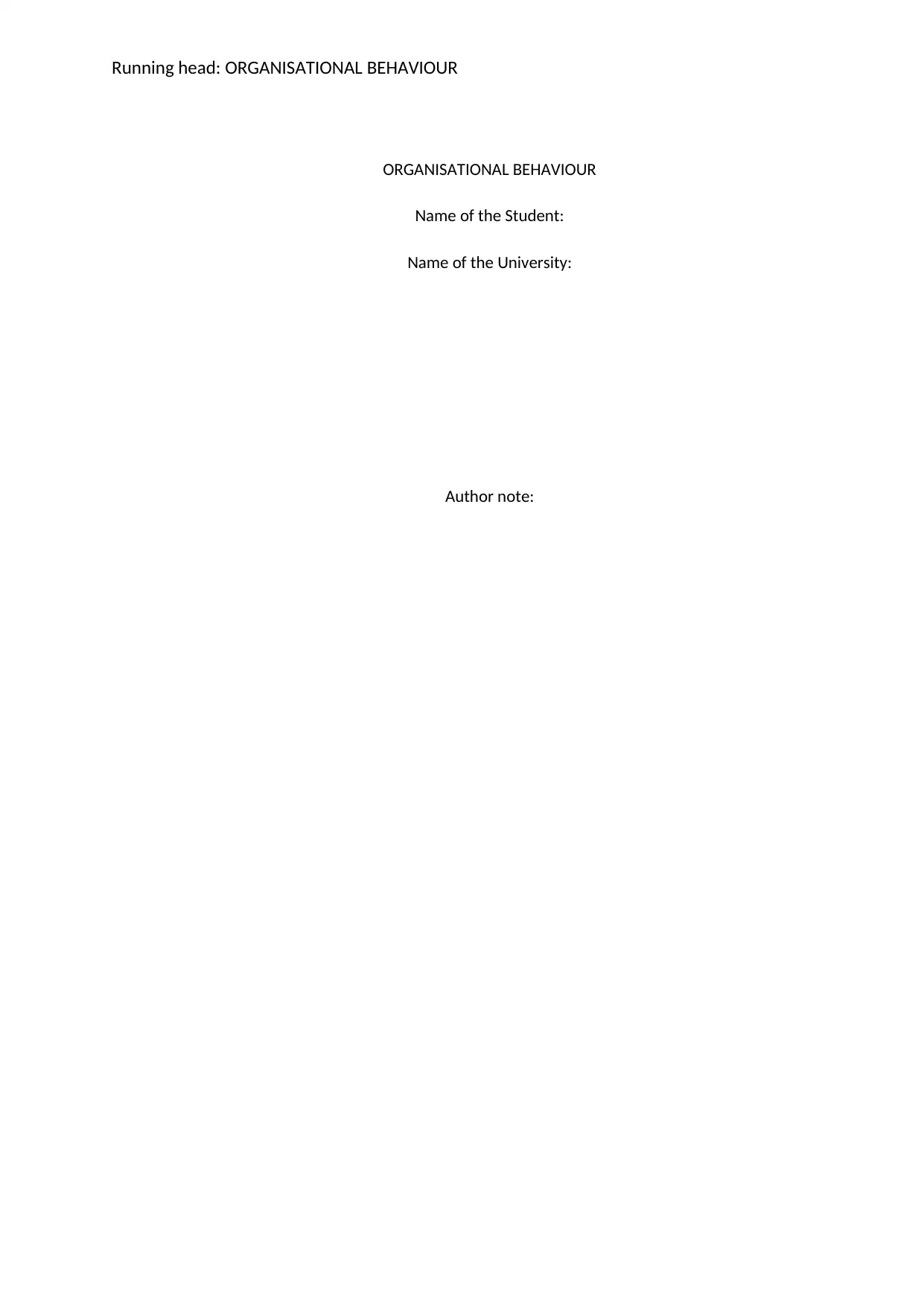
Running head: ORGANISATIONAL BEHAVIOUR
ORGANISATIONAL BEHAVIOUR
Name of the Student:
Name of the University:
Author note:
ORGANISATIONAL BEHAVIOUR
Name of the Student:
Name of the University:
Author note:
Paraphrase This Document
Need a fresh take? Get an instant paraphrase of this document with our AI Paraphraser
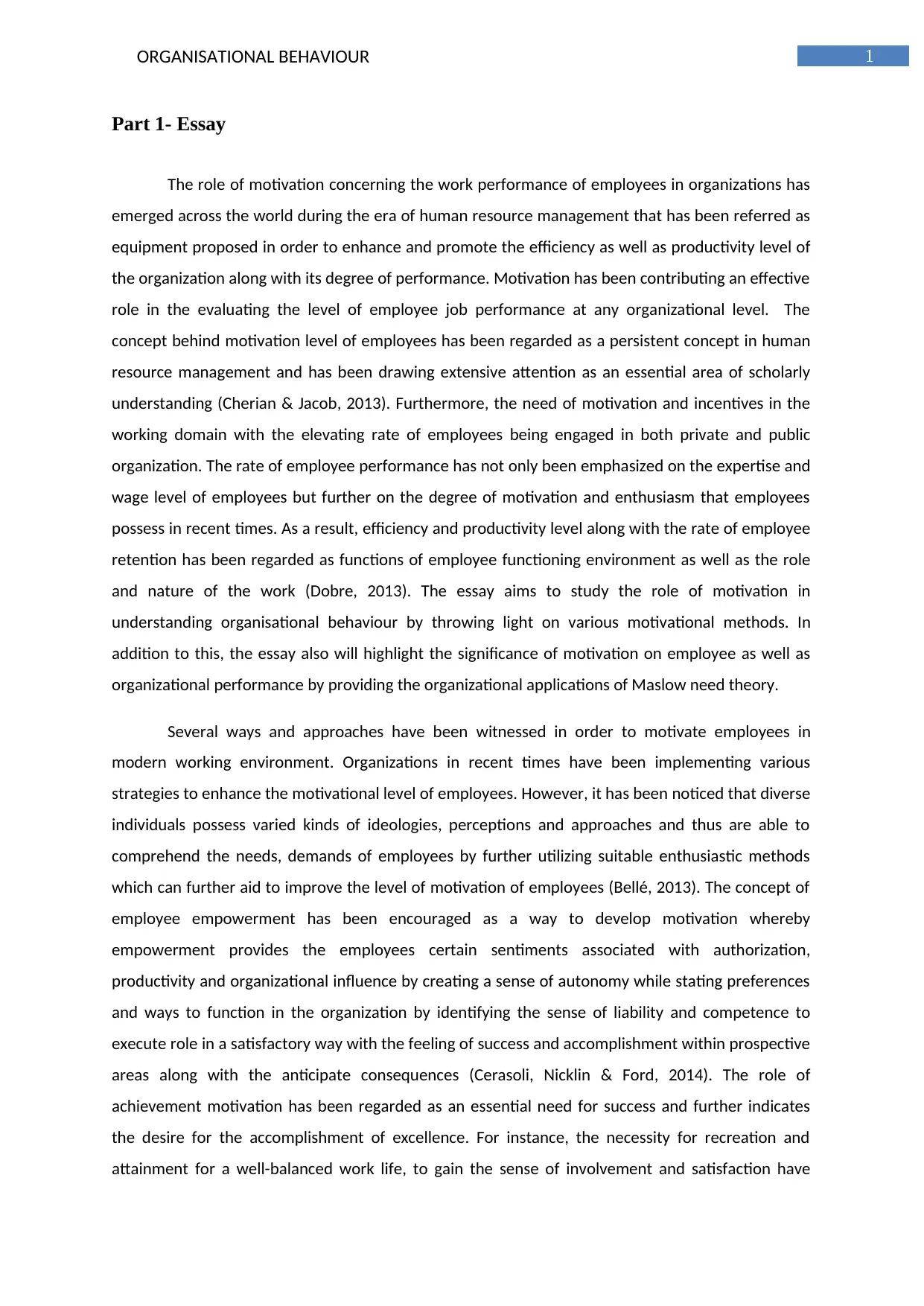
1ORGANISATIONAL BEHAVIOUR
Part 1- Essay
The role of motivation concerning the work performance of employees in organizations has
emerged across the world during the era of human resource management that has been referred as
equipment proposed in order to enhance and promote the efficiency as well as productivity level of
the organization along with its degree of performance. Motivation has been contributing an effective
role in the evaluating the level of employee job performance at any organizational level. The
concept behind motivation level of employees has been regarded as a persistent concept in human
resource management and has been drawing extensive attention as an essential area of scholarly
understanding (Cherian & Jacob, 2013). Furthermore, the need of motivation and incentives in the
working domain with the elevating rate of employees being engaged in both private and public
organization. The rate of employee performance has not only been emphasized on the expertise and
wage level of employees but further on the degree of motivation and enthusiasm that employees
possess in recent times. As a result, efficiency and productivity level along with the rate of employee
retention has been regarded as functions of employee functioning environment as well as the role
and nature of the work (Dobre, 2013). The essay aims to study the role of motivation in
understanding organisational behaviour by throwing light on various motivational methods. In
addition to this, the essay also will highlight the significance of motivation on employee as well as
organizational performance by providing the organizational applications of Maslow need theory.
Several ways and approaches have been witnessed in order to motivate employees in
modern working environment. Organizations in recent times have been implementing various
strategies to enhance the motivational level of employees. However, it has been noticed that diverse
individuals possess varied kinds of ideologies, perceptions and approaches and thus are able to
comprehend the needs, demands of employees by further utilizing suitable enthusiastic methods
which can further aid to improve the level of motivation of employees (Bellé, 2013). The concept of
employee empowerment has been encouraged as a way to develop motivation whereby
empowerment provides the employees certain sentiments associated with authorization,
productivity and organizational influence by creating a sense of autonomy while stating preferences
and ways to function in the organization by identifying the sense of liability and competence to
execute role in a satisfactory way with the feeling of success and accomplishment within prospective
areas along with the anticipate consequences (Cerasoli, Nicklin & Ford, 2014). The role of
achievement motivation has been regarded as an essential need for success and further indicates
the desire for the accomplishment of excellence. For instance, the necessity for recreation and
attainment for a well-balanced work life, to gain the sense of involvement and satisfaction have
Part 1- Essay
The role of motivation concerning the work performance of employees in organizations has
emerged across the world during the era of human resource management that has been referred as
equipment proposed in order to enhance and promote the efficiency as well as productivity level of
the organization along with its degree of performance. Motivation has been contributing an effective
role in the evaluating the level of employee job performance at any organizational level. The
concept behind motivation level of employees has been regarded as a persistent concept in human
resource management and has been drawing extensive attention as an essential area of scholarly
understanding (Cherian & Jacob, 2013). Furthermore, the need of motivation and incentives in the
working domain with the elevating rate of employees being engaged in both private and public
organization. The rate of employee performance has not only been emphasized on the expertise and
wage level of employees but further on the degree of motivation and enthusiasm that employees
possess in recent times. As a result, efficiency and productivity level along with the rate of employee
retention has been regarded as functions of employee functioning environment as well as the role
and nature of the work (Dobre, 2013). The essay aims to study the role of motivation in
understanding organisational behaviour by throwing light on various motivational methods. In
addition to this, the essay also will highlight the significance of motivation on employee as well as
organizational performance by providing the organizational applications of Maslow need theory.
Several ways and approaches have been witnessed in order to motivate employees in
modern working environment. Organizations in recent times have been implementing various
strategies to enhance the motivational level of employees. However, it has been noticed that diverse
individuals possess varied kinds of ideologies, perceptions and approaches and thus are able to
comprehend the needs, demands of employees by further utilizing suitable enthusiastic methods
which can further aid to improve the level of motivation of employees (Bellé, 2013). The concept of
employee empowerment has been encouraged as a way to develop motivation whereby
empowerment provides the employees certain sentiments associated with authorization,
productivity and organizational influence by creating a sense of autonomy while stating preferences
and ways to function in the organization by identifying the sense of liability and competence to
execute role in a satisfactory way with the feeling of success and accomplishment within prospective
areas along with the anticipate consequences (Cerasoli, Nicklin & Ford, 2014). The role of
achievement motivation has been regarded as an essential need for success and further indicates
the desire for the accomplishment of excellence. For instance, the necessity for recreation and
attainment for a well-balanced work life, to gain the sense of involvement and satisfaction have
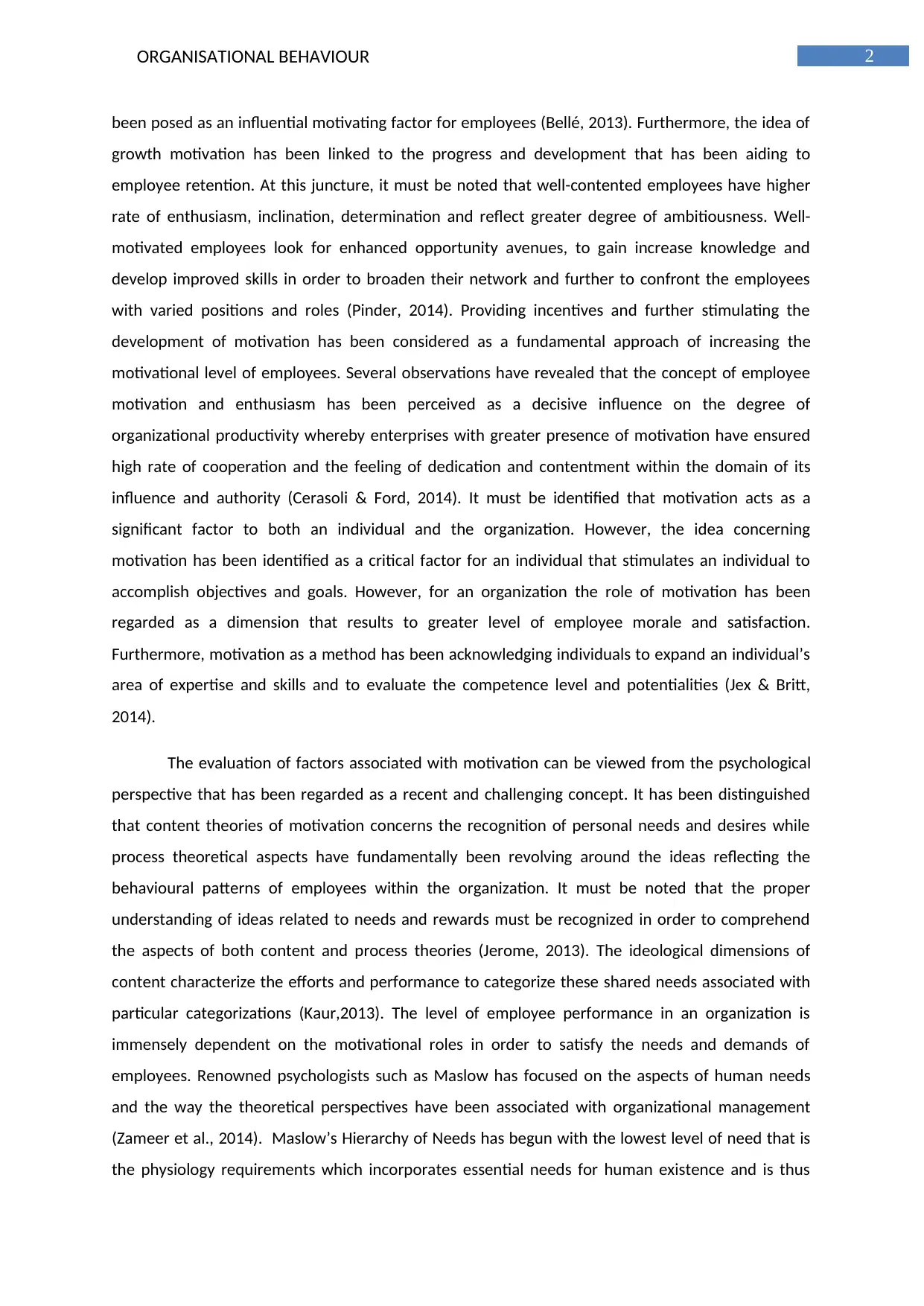
2ORGANISATIONAL BEHAVIOUR
been posed as an influential motivating factor for employees (Bellé, 2013). Furthermore, the idea of
growth motivation has been linked to the progress and development that has been aiding to
employee retention. At this juncture, it must be noted that well-contented employees have higher
rate of enthusiasm, inclination, determination and reflect greater degree of ambitiousness. Well-
motivated employees look for enhanced opportunity avenues, to gain increase knowledge and
develop improved skills in order to broaden their network and further to confront the employees
with varied positions and roles (Pinder, 2014). Providing incentives and further stimulating the
development of motivation has been considered as a fundamental approach of increasing the
motivational level of employees. Several observations have revealed that the concept of employee
motivation and enthusiasm has been perceived as a decisive influence on the degree of
organizational productivity whereby enterprises with greater presence of motivation have ensured
high rate of cooperation and the feeling of dedication and contentment within the domain of its
influence and authority (Cerasoli & Ford, 2014). It must be identified that motivation acts as a
significant factor to both an individual and the organization. However, the idea concerning
motivation has been identified as a critical factor for an individual that stimulates an individual to
accomplish objectives and goals. However, for an organization the role of motivation has been
regarded as a dimension that results to greater level of employee morale and satisfaction.
Furthermore, motivation as a method has been acknowledging individuals to expand an individual’s
area of expertise and skills and to evaluate the competence level and potentialities (Jex & Britt,
2014).
The evaluation of factors associated with motivation can be viewed from the psychological
perspective that has been regarded as a recent and challenging concept. It has been distinguished
that content theories of motivation concerns the recognition of personal needs and desires while
process theoretical aspects have fundamentally been revolving around the ideas reflecting the
behavioural patterns of employees within the organization. It must be noted that the proper
understanding of ideas related to needs and rewards must be recognized in order to comprehend
the aspects of both content and process theories (Jerome, 2013). The ideological dimensions of
content characterize the efforts and performance to categorize these shared needs associated with
particular categorizations (Kaur,2013). The level of employee performance in an organization is
immensely dependent on the motivational roles in order to satisfy the needs and demands of
employees. Renowned psychologists such as Maslow has focused on the aspects of human needs
and the way the theoretical perspectives have been associated with organizational management
(Zameer et al., 2014). Maslow’s Hierarchy of Needs has begun with the lowest level of need that is
the physiology requirements which incorporates essential needs for human existence and is thus
been posed as an influential motivating factor for employees (Bellé, 2013). Furthermore, the idea of
growth motivation has been linked to the progress and development that has been aiding to
employee retention. At this juncture, it must be noted that well-contented employees have higher
rate of enthusiasm, inclination, determination and reflect greater degree of ambitiousness. Well-
motivated employees look for enhanced opportunity avenues, to gain increase knowledge and
develop improved skills in order to broaden their network and further to confront the employees
with varied positions and roles (Pinder, 2014). Providing incentives and further stimulating the
development of motivation has been considered as a fundamental approach of increasing the
motivational level of employees. Several observations have revealed that the concept of employee
motivation and enthusiasm has been perceived as a decisive influence on the degree of
organizational productivity whereby enterprises with greater presence of motivation have ensured
high rate of cooperation and the feeling of dedication and contentment within the domain of its
influence and authority (Cerasoli & Ford, 2014). It must be identified that motivation acts as a
significant factor to both an individual and the organization. However, the idea concerning
motivation has been identified as a critical factor for an individual that stimulates an individual to
accomplish objectives and goals. However, for an organization the role of motivation has been
regarded as a dimension that results to greater level of employee morale and satisfaction.
Furthermore, motivation as a method has been acknowledging individuals to expand an individual’s
area of expertise and skills and to evaluate the competence level and potentialities (Jex & Britt,
2014).
The evaluation of factors associated with motivation can be viewed from the psychological
perspective that has been regarded as a recent and challenging concept. It has been distinguished
that content theories of motivation concerns the recognition of personal needs and desires while
process theoretical aspects have fundamentally been revolving around the ideas reflecting the
behavioural patterns of employees within the organization. It must be noted that the proper
understanding of ideas related to needs and rewards must be recognized in order to comprehend
the aspects of both content and process theories (Jerome, 2013). The ideological dimensions of
content characterize the efforts and performance to categorize these shared needs associated with
particular categorizations (Kaur,2013). The level of employee performance in an organization is
immensely dependent on the motivational roles in order to satisfy the needs and demands of
employees. Renowned psychologists such as Maslow has focused on the aspects of human needs
and the way the theoretical perspectives have been associated with organizational management
(Zameer et al., 2014). Maslow’s Hierarchy of Needs has begun with the lowest level of need that is
the physiology requirements which incorporates essential needs for human existence and is thus
⊘ This is a preview!⊘
Do you want full access?
Subscribe today to unlock all pages.

Trusted by 1+ million students worldwide
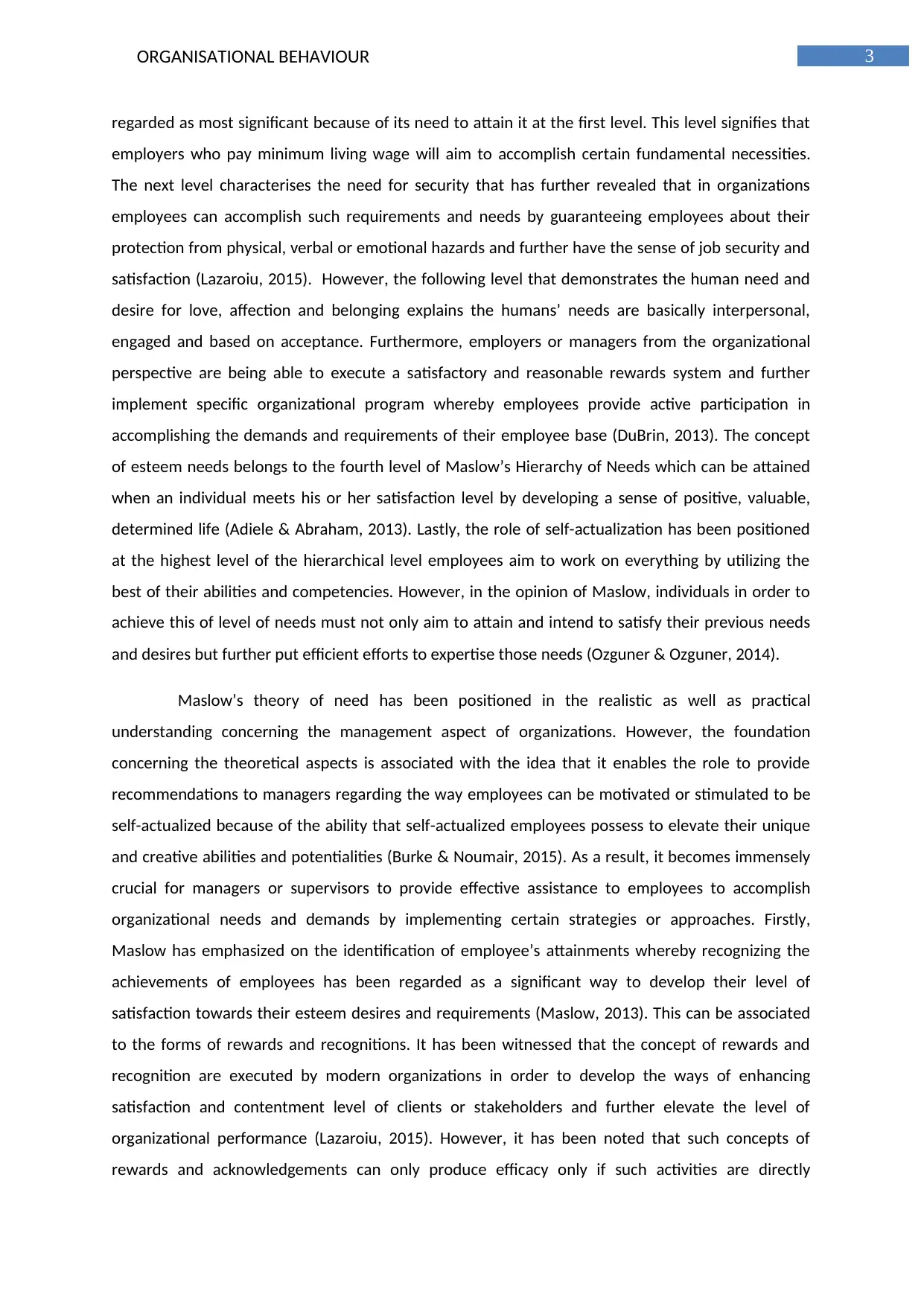
3ORGANISATIONAL BEHAVIOUR
regarded as most significant because of its need to attain it at the first level. This level signifies that
employers who pay minimum living wage will aim to accomplish certain fundamental necessities.
The next level characterises the need for security that has further revealed that in organizations
employees can accomplish such requirements and needs by guaranteeing employees about their
protection from physical, verbal or emotional hazards and further have the sense of job security and
satisfaction (Lazaroiu, 2015). However, the following level that demonstrates the human need and
desire for love, affection and belonging explains the humans’ needs are basically interpersonal,
engaged and based on acceptance. Furthermore, employers or managers from the organizational
perspective are being able to execute a satisfactory and reasonable rewards system and further
implement specific organizational program whereby employees provide active participation in
accomplishing the demands and requirements of their employee base (DuBrin, 2013). The concept
of esteem needs belongs to the fourth level of Maslow’s Hierarchy of Needs which can be attained
when an individual meets his or her satisfaction level by developing a sense of positive, valuable,
determined life (Adiele & Abraham, 2013). Lastly, the role of self-actualization has been positioned
at the highest level of the hierarchical level employees aim to work on everything by utilizing the
best of their abilities and competencies. However, in the opinion of Maslow, individuals in order to
achieve this of level of needs must not only aim to attain and intend to satisfy their previous needs
and desires but further put efficient efforts to expertise those needs (Ozguner & Ozguner, 2014).
Maslow’s theory of need has been positioned in the realistic as well as practical
understanding concerning the management aspect of organizations. However, the foundation
concerning the theoretical aspects is associated with the idea that it enables the role to provide
recommendations to managers regarding the way employees can be motivated or stimulated to be
self-actualized because of the ability that self-actualized employees possess to elevate their unique
and creative abilities and potentialities (Burke & Noumair, 2015). As a result, it becomes immensely
crucial for managers or supervisors to provide effective assistance to employees to accomplish
organizational needs and demands by implementing certain strategies or approaches. Firstly,
Maslow has emphasized on the identification of employee’s attainments whereby recognizing the
achievements of employees has been regarded as a significant way to develop their level of
satisfaction towards their esteem desires and requirements (Maslow, 2013). This can be associated
to the forms of rewards and recognitions. It has been witnessed that the concept of rewards and
recognition are executed by modern organizations in order to develop the ways of enhancing
satisfaction and contentment level of clients or stakeholders and further elevate the level of
organizational performance (Lazaroiu, 2015). However, it has been noted that such concepts of
rewards and acknowledgements can only produce efficacy only if such activities are directly
regarded as most significant because of its need to attain it at the first level. This level signifies that
employers who pay minimum living wage will aim to accomplish certain fundamental necessities.
The next level characterises the need for security that has further revealed that in organizations
employees can accomplish such requirements and needs by guaranteeing employees about their
protection from physical, verbal or emotional hazards and further have the sense of job security and
satisfaction (Lazaroiu, 2015). However, the following level that demonstrates the human need and
desire for love, affection and belonging explains the humans’ needs are basically interpersonal,
engaged and based on acceptance. Furthermore, employers or managers from the organizational
perspective are being able to execute a satisfactory and reasonable rewards system and further
implement specific organizational program whereby employees provide active participation in
accomplishing the demands and requirements of their employee base (DuBrin, 2013). The concept
of esteem needs belongs to the fourth level of Maslow’s Hierarchy of Needs which can be attained
when an individual meets his or her satisfaction level by developing a sense of positive, valuable,
determined life (Adiele & Abraham, 2013). Lastly, the role of self-actualization has been positioned
at the highest level of the hierarchical level employees aim to work on everything by utilizing the
best of their abilities and competencies. However, in the opinion of Maslow, individuals in order to
achieve this of level of needs must not only aim to attain and intend to satisfy their previous needs
and desires but further put efficient efforts to expertise those needs (Ozguner & Ozguner, 2014).
Maslow’s theory of need has been positioned in the realistic as well as practical
understanding concerning the management aspect of organizations. However, the foundation
concerning the theoretical aspects is associated with the idea that it enables the role to provide
recommendations to managers regarding the way employees can be motivated or stimulated to be
self-actualized because of the ability that self-actualized employees possess to elevate their unique
and creative abilities and potentialities (Burke & Noumair, 2015). As a result, it becomes immensely
crucial for managers or supervisors to provide effective assistance to employees to accomplish
organizational needs and demands by implementing certain strategies or approaches. Firstly,
Maslow has emphasized on the identification of employee’s attainments whereby recognizing the
achievements of employees has been regarded as a significant way to develop their level of
satisfaction towards their esteem desires and requirements (Maslow, 2013). This can be associated
to the forms of rewards and recognitions. It has been witnessed that the concept of rewards and
recognition are executed by modern organizations in order to develop the ways of enhancing
satisfaction and contentment level of clients or stakeholders and further elevate the level of
organizational performance (Lazaroiu, 2015). However, it has been noted that such concepts of
rewards and acknowledgements can only produce efficacy only if such activities are directly
Paraphrase This Document
Need a fresh take? Get an instant paraphrase of this document with our AI Paraphraser
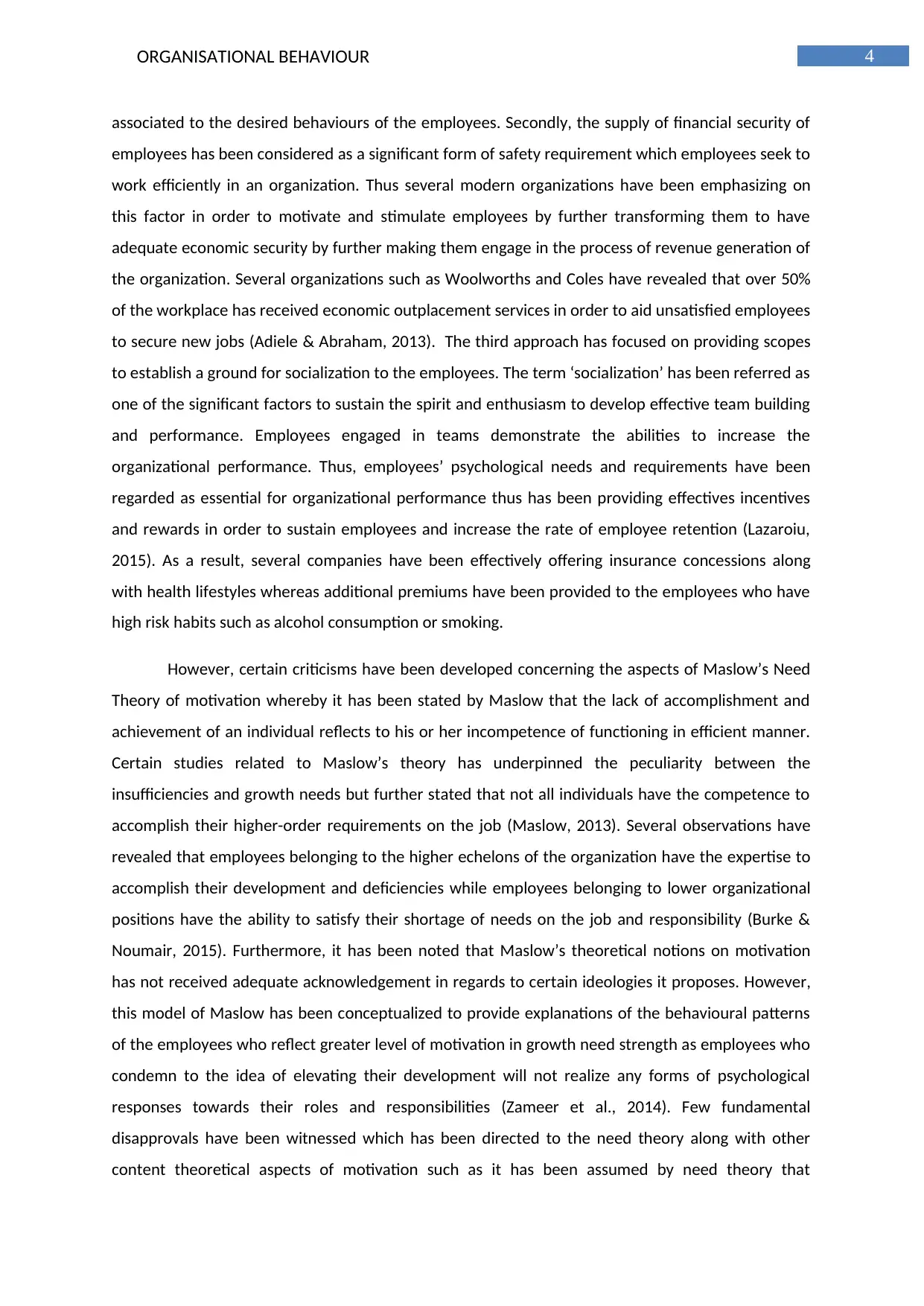
4ORGANISATIONAL BEHAVIOUR
associated to the desired behaviours of the employees. Secondly, the supply of financial security of
employees has been considered as a significant form of safety requirement which employees seek to
work efficiently in an organization. Thus several modern organizations have been emphasizing on
this factor in order to motivate and stimulate employees by further transforming them to have
adequate economic security by further making them engage in the process of revenue generation of
the organization. Several organizations such as Woolworths and Coles have revealed that over 50%
of the workplace has received economic outplacement services in order to aid unsatisfied employees
to secure new jobs (Adiele & Abraham, 2013). The third approach has focused on providing scopes
to establish a ground for socialization to the employees. The term ‘socialization’ has been referred as
one of the significant factors to sustain the spirit and enthusiasm to develop effective team building
and performance. Employees engaged in teams demonstrate the abilities to increase the
organizational performance. Thus, employees’ psychological needs and requirements have been
regarded as essential for organizational performance thus has been providing effectives incentives
and rewards in order to sustain employees and increase the rate of employee retention (Lazaroiu,
2015). As a result, several companies have been effectively offering insurance concessions along
with health lifestyles whereas additional premiums have been provided to the employees who have
high risk habits such as alcohol consumption or smoking.
However, certain criticisms have been developed concerning the aspects of Maslow’s Need
Theory of motivation whereby it has been stated by Maslow that the lack of accomplishment and
achievement of an individual reflects to his or her incompetence of functioning in efficient manner.
Certain studies related to Maslow’s theory has underpinned the peculiarity between the
insufficiencies and growth needs but further stated that not all individuals have the competence to
accomplish their higher-order requirements on the job (Maslow, 2013). Several observations have
revealed that employees belonging to the higher echelons of the organization have the expertise to
accomplish their development and deficiencies while employees belonging to lower organizational
positions have the ability to satisfy their shortage of needs on the job and responsibility (Burke &
Noumair, 2015). Furthermore, it has been noted that Maslow’s theoretical notions on motivation
has not received adequate acknowledgement in regards to certain ideologies it proposes. However,
this model of Maslow has been conceptualized to provide explanations of the behavioural patterns
of the employees who reflect greater level of motivation in growth need strength as employees who
condemn to the idea of elevating their development will not realize any forms of psychological
responses towards their roles and responsibilities (Zameer et al., 2014). Few fundamental
disapprovals have been witnessed which has been directed to the need theory along with other
content theoretical aspects of motivation such as it has been assumed by need theory that
associated to the desired behaviours of the employees. Secondly, the supply of financial security of
employees has been considered as a significant form of safety requirement which employees seek to
work efficiently in an organization. Thus several modern organizations have been emphasizing on
this factor in order to motivate and stimulate employees by further transforming them to have
adequate economic security by further making them engage in the process of revenue generation of
the organization. Several organizations such as Woolworths and Coles have revealed that over 50%
of the workplace has received economic outplacement services in order to aid unsatisfied employees
to secure new jobs (Adiele & Abraham, 2013). The third approach has focused on providing scopes
to establish a ground for socialization to the employees. The term ‘socialization’ has been referred as
one of the significant factors to sustain the spirit and enthusiasm to develop effective team building
and performance. Employees engaged in teams demonstrate the abilities to increase the
organizational performance. Thus, employees’ psychological needs and requirements have been
regarded as essential for organizational performance thus has been providing effectives incentives
and rewards in order to sustain employees and increase the rate of employee retention (Lazaroiu,
2015). As a result, several companies have been effectively offering insurance concessions along
with health lifestyles whereas additional premiums have been provided to the employees who have
high risk habits such as alcohol consumption or smoking.
However, certain criticisms have been developed concerning the aspects of Maslow’s Need
Theory of motivation whereby it has been stated by Maslow that the lack of accomplishment and
achievement of an individual reflects to his or her incompetence of functioning in efficient manner.
Certain studies related to Maslow’s theory has underpinned the peculiarity between the
insufficiencies and growth needs but further stated that not all individuals have the competence to
accomplish their higher-order requirements on the job (Maslow, 2013). Several observations have
revealed that employees belonging to the higher echelons of the organization have the expertise to
accomplish their development and deficiencies while employees belonging to lower organizational
positions have the ability to satisfy their shortage of needs on the job and responsibility (Burke &
Noumair, 2015). Furthermore, it has been noted that Maslow’s theoretical notions on motivation
has not received adequate acknowledgement in regards to certain ideologies it proposes. However,
this model of Maslow has been conceptualized to provide explanations of the behavioural patterns
of the employees who reflect greater level of motivation in growth need strength as employees who
condemn to the idea of elevating their development will not realize any forms of psychological
responses towards their roles and responsibilities (Zameer et al., 2014). Few fundamental
disapprovals have been witnessed which has been directed to the need theory along with other
content theoretical aspects of motivation such as it has been assumed by need theory that
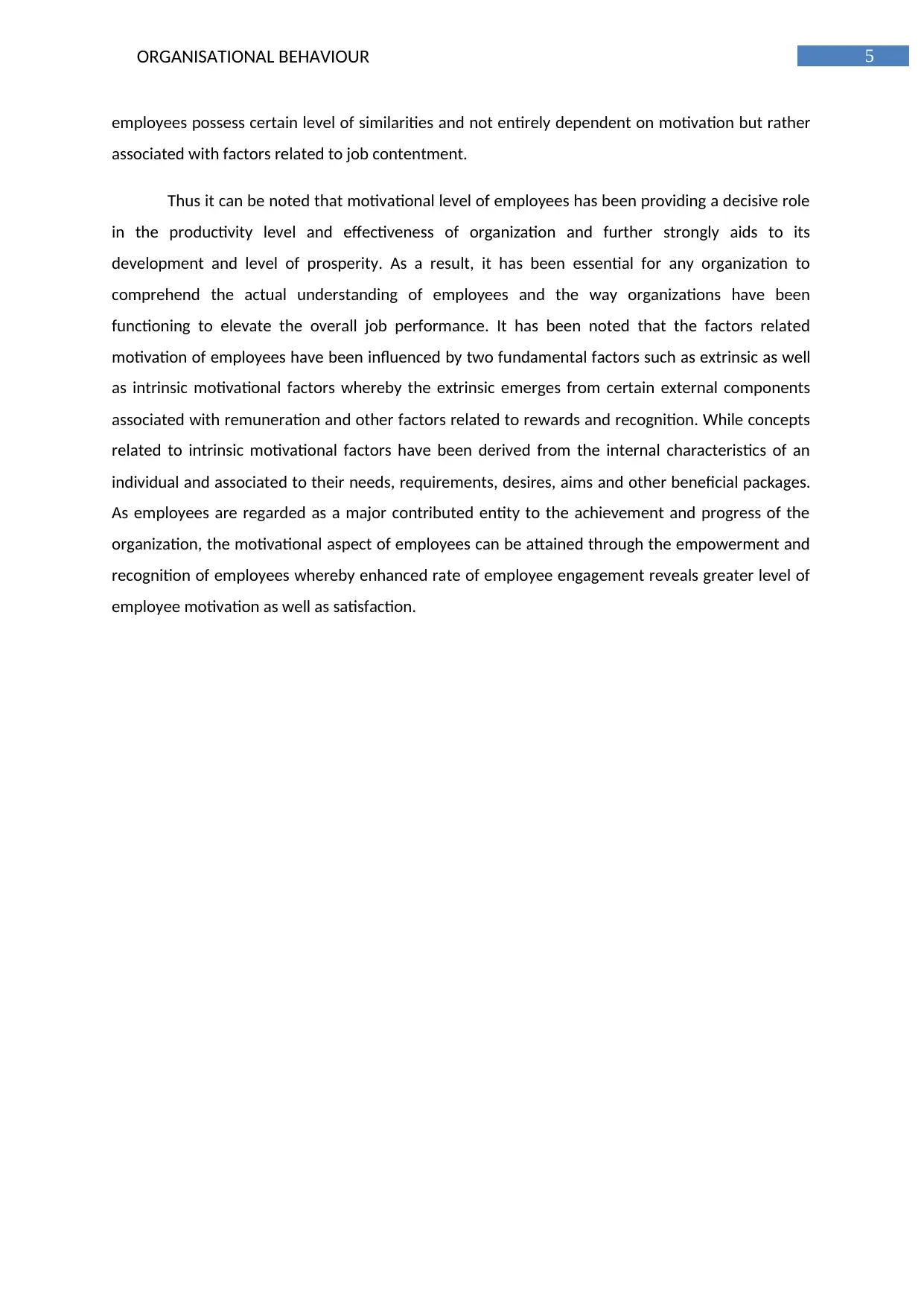
5ORGANISATIONAL BEHAVIOUR
employees possess certain level of similarities and not entirely dependent on motivation but rather
associated with factors related to job contentment.
Thus it can be noted that motivational level of employees has been providing a decisive role
in the productivity level and effectiveness of organization and further strongly aids to its
development and level of prosperity. As a result, it has been essential for any organization to
comprehend the actual understanding of employees and the way organizations have been
functioning to elevate the overall job performance. It has been noted that the factors related
motivation of employees have been influenced by two fundamental factors such as extrinsic as well
as intrinsic motivational factors whereby the extrinsic emerges from certain external components
associated with remuneration and other factors related to rewards and recognition. While concepts
related to intrinsic motivational factors have been derived from the internal characteristics of an
individual and associated to their needs, requirements, desires, aims and other beneficial packages.
As employees are regarded as a major contributed entity to the achievement and progress of the
organization, the motivational aspect of employees can be attained through the empowerment and
recognition of employees whereby enhanced rate of employee engagement reveals greater level of
employee motivation as well as satisfaction.
employees possess certain level of similarities and not entirely dependent on motivation but rather
associated with factors related to job contentment.
Thus it can be noted that motivational level of employees has been providing a decisive role
in the productivity level and effectiveness of organization and further strongly aids to its
development and level of prosperity. As a result, it has been essential for any organization to
comprehend the actual understanding of employees and the way organizations have been
functioning to elevate the overall job performance. It has been noted that the factors related
motivation of employees have been influenced by two fundamental factors such as extrinsic as well
as intrinsic motivational factors whereby the extrinsic emerges from certain external components
associated with remuneration and other factors related to rewards and recognition. While concepts
related to intrinsic motivational factors have been derived from the internal characteristics of an
individual and associated to their needs, requirements, desires, aims and other beneficial packages.
As employees are regarded as a major contributed entity to the achievement and progress of the
organization, the motivational aspect of employees can be attained through the empowerment and
recognition of employees whereby enhanced rate of employee engagement reveals greater level of
employee motivation as well as satisfaction.
⊘ This is a preview!⊘
Do you want full access?
Subscribe today to unlock all pages.

Trusted by 1+ million students worldwide
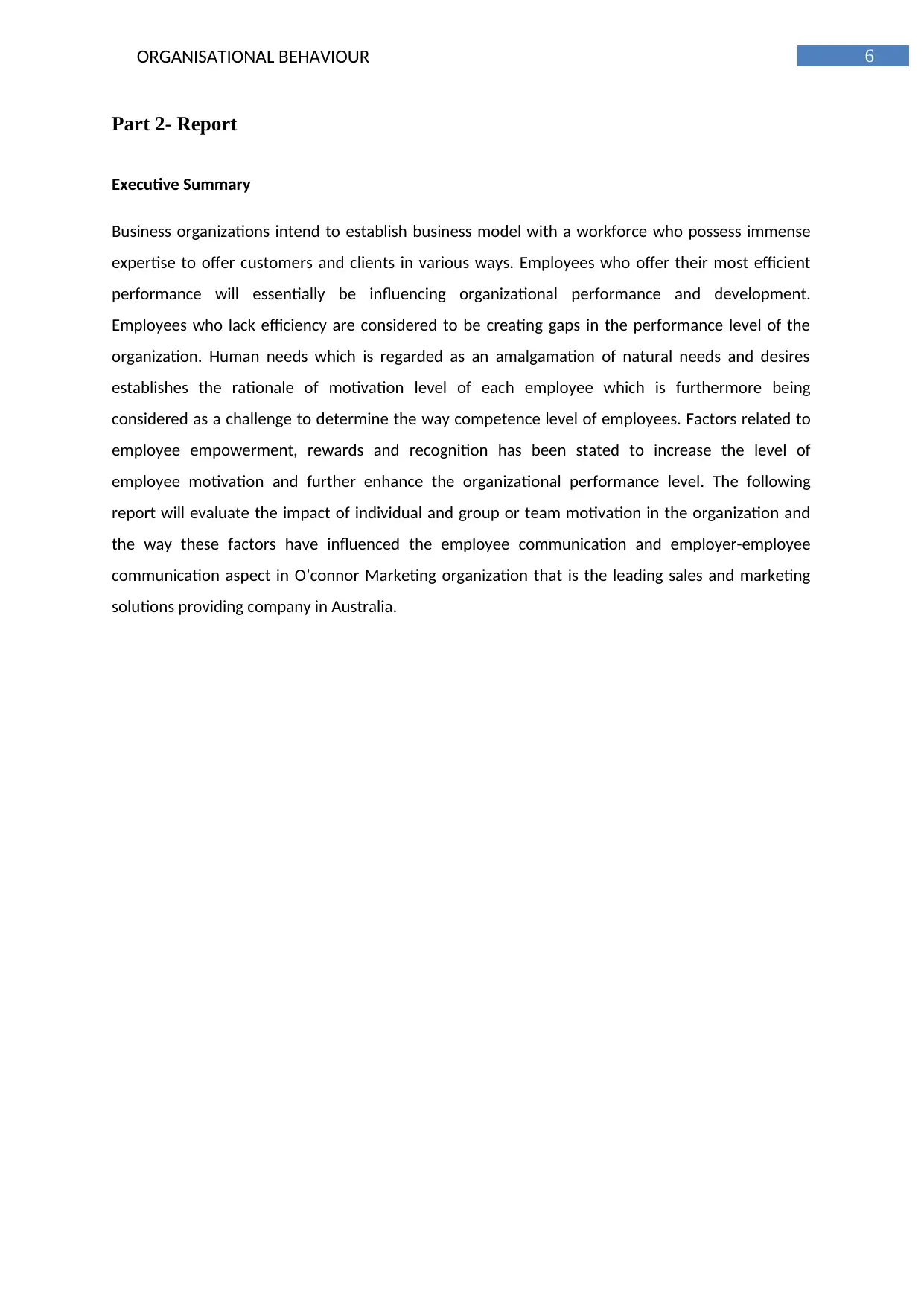
6ORGANISATIONAL BEHAVIOUR
Part 2- Report
Executive Summary
Business organizations intend to establish business model with a workforce who possess immense
expertise to offer customers and clients in various ways. Employees who offer their most efficient
performance will essentially be influencing organizational performance and development.
Employees who lack efficiency are considered to be creating gaps in the performance level of the
organization. Human needs which is regarded as an amalgamation of natural needs and desires
establishes the rationale of motivation level of each employee which is furthermore being
considered as a challenge to determine the way competence level of employees. Factors related to
employee empowerment, rewards and recognition has been stated to increase the level of
employee motivation and further enhance the organizational performance level. The following
report will evaluate the impact of individual and group or team motivation in the organization and
the way these factors have influenced the employee communication and employer-employee
communication aspect in O’connor Marketing organization that is the leading sales and marketing
solutions providing company in Australia.
Part 2- Report
Executive Summary
Business organizations intend to establish business model with a workforce who possess immense
expertise to offer customers and clients in various ways. Employees who offer their most efficient
performance will essentially be influencing organizational performance and development.
Employees who lack efficiency are considered to be creating gaps in the performance level of the
organization. Human needs which is regarded as an amalgamation of natural needs and desires
establishes the rationale of motivation level of each employee which is furthermore being
considered as a challenge to determine the way competence level of employees. Factors related to
employee empowerment, rewards and recognition has been stated to increase the level of
employee motivation and further enhance the organizational performance level. The following
report will evaluate the impact of individual and group or team motivation in the organization and
the way these factors have influenced the employee communication and employer-employee
communication aspect in O’connor Marketing organization that is the leading sales and marketing
solutions providing company in Australia.
Paraphrase This Document
Need a fresh take? Get an instant paraphrase of this document with our AI Paraphraser
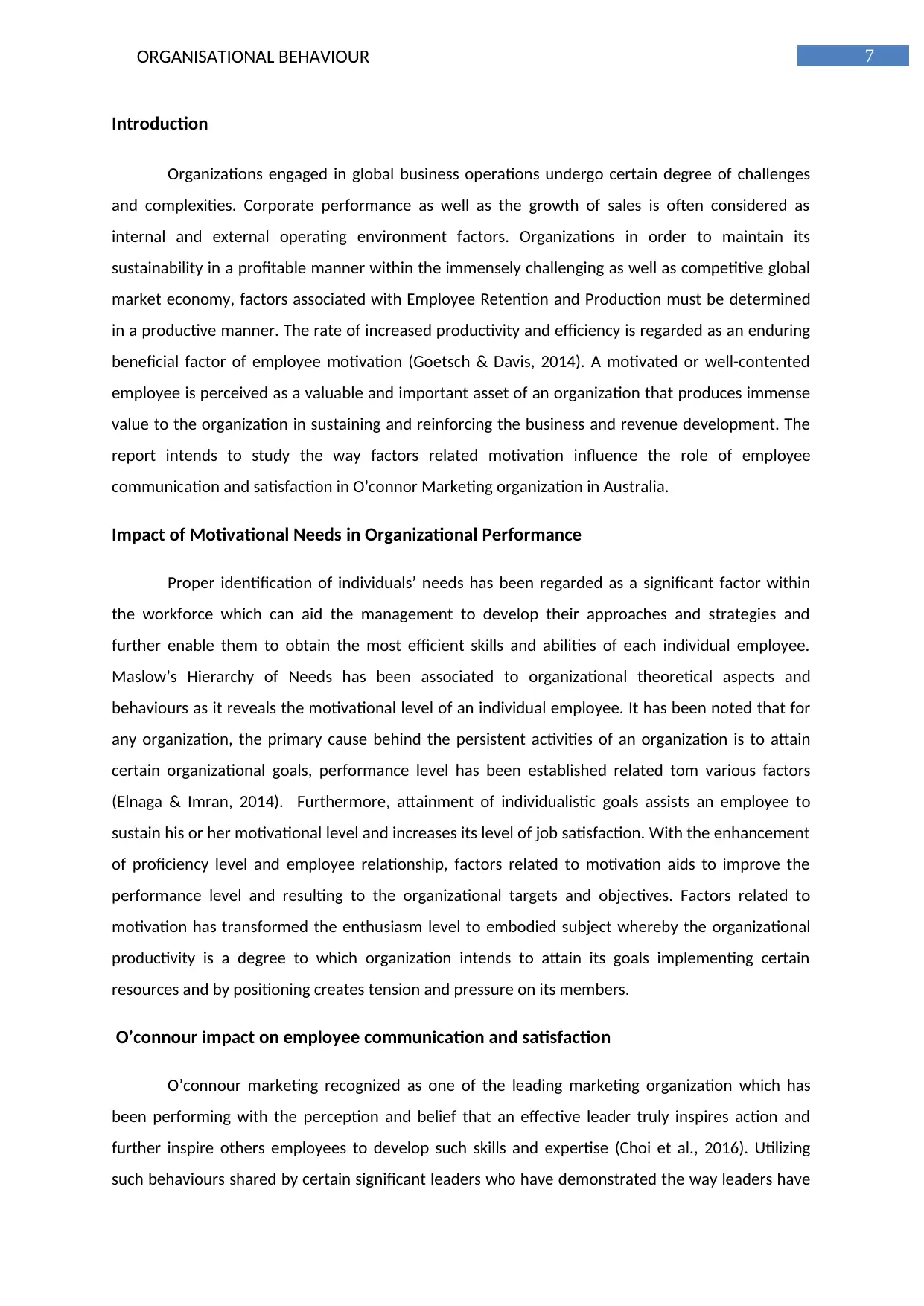
7ORGANISATIONAL BEHAVIOUR
Introduction
Organizations engaged in global business operations undergo certain degree of challenges
and complexities. Corporate performance as well as the growth of sales is often considered as
internal and external operating environment factors. Organizations in order to maintain its
sustainability in a profitable manner within the immensely challenging as well as competitive global
market economy, factors associated with Employee Retention and Production must be determined
in a productive manner. The rate of increased productivity and efficiency is regarded as an enduring
beneficial factor of employee motivation (Goetsch & Davis, 2014). A motivated or well-contented
employee is perceived as a valuable and important asset of an organization that produces immense
value to the organization in sustaining and reinforcing the business and revenue development. The
report intends to study the way factors related motivation influence the role of employee
communication and satisfaction in O’connor Marketing organization in Australia.
Impact of Motivational Needs in Organizational Performance
Proper identification of individuals’ needs has been regarded as a significant factor within
the workforce which can aid the management to develop their approaches and strategies and
further enable them to obtain the most efficient skills and abilities of each individual employee.
Maslow’s Hierarchy of Needs has been associated to organizational theoretical aspects and
behaviours as it reveals the motivational level of an individual employee. It has been noted that for
any organization, the primary cause behind the persistent activities of an organization is to attain
certain organizational goals, performance level has been established related tom various factors
(Elnaga & Imran, 2014). Furthermore, attainment of individualistic goals assists an employee to
sustain his or her motivational level and increases its level of job satisfaction. With the enhancement
of proficiency level and employee relationship, factors related to motivation aids to improve the
performance level and resulting to the organizational targets and objectives. Factors related to
motivation has transformed the enthusiasm level to embodied subject whereby the organizational
productivity is a degree to which organization intends to attain its goals implementing certain
resources and by positioning creates tension and pressure on its members.
O’connour impact on employee communication and satisfaction
O’connour marketing recognized as one of the leading marketing organization which has
been performing with the perception and belief that an effective leader truly inspires action and
further inspire others employees to develop such skills and expertise (Choi et al., 2016). Utilizing
such behaviours shared by certain significant leaders who have demonstrated the way leaders have
Introduction
Organizations engaged in global business operations undergo certain degree of challenges
and complexities. Corporate performance as well as the growth of sales is often considered as
internal and external operating environment factors. Organizations in order to maintain its
sustainability in a profitable manner within the immensely challenging as well as competitive global
market economy, factors associated with Employee Retention and Production must be determined
in a productive manner. The rate of increased productivity and efficiency is regarded as an enduring
beneficial factor of employee motivation (Goetsch & Davis, 2014). A motivated or well-contented
employee is perceived as a valuable and important asset of an organization that produces immense
value to the organization in sustaining and reinforcing the business and revenue development. The
report intends to study the way factors related motivation influence the role of employee
communication and satisfaction in O’connor Marketing organization in Australia.
Impact of Motivational Needs in Organizational Performance
Proper identification of individuals’ needs has been regarded as a significant factor within
the workforce which can aid the management to develop their approaches and strategies and
further enable them to obtain the most efficient skills and abilities of each individual employee.
Maslow’s Hierarchy of Needs has been associated to organizational theoretical aspects and
behaviours as it reveals the motivational level of an individual employee. It has been noted that for
any organization, the primary cause behind the persistent activities of an organization is to attain
certain organizational goals, performance level has been established related tom various factors
(Elnaga & Imran, 2014). Furthermore, attainment of individualistic goals assists an employee to
sustain his or her motivational level and increases its level of job satisfaction. With the enhancement
of proficiency level and employee relationship, factors related to motivation aids to improve the
performance level and resulting to the organizational targets and objectives. Factors related to
motivation has transformed the enthusiasm level to embodied subject whereby the organizational
productivity is a degree to which organization intends to attain its goals implementing certain
resources and by positioning creates tension and pressure on its members.
O’connour impact on employee communication and satisfaction
O’connour marketing recognized as one of the leading marketing organization which has
been performing with the perception and belief that an effective leader truly inspires action and
further inspire others employees to develop such skills and expertise (Choi et al., 2016). Utilizing
such behaviours shared by certain significant leaders who have demonstrated the way leaders have
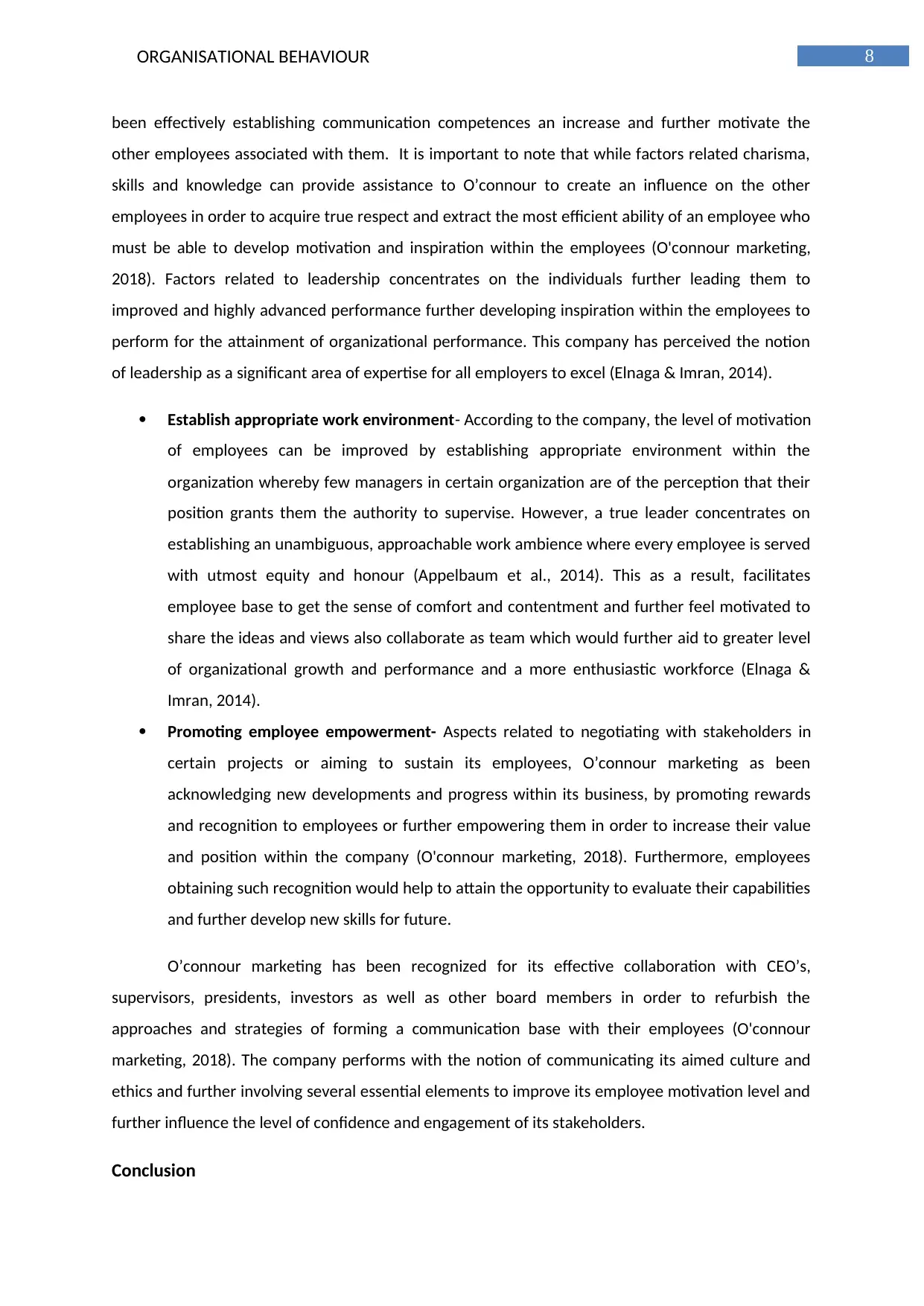
8ORGANISATIONAL BEHAVIOUR
been effectively establishing communication competences an increase and further motivate the
other employees associated with them. It is important to note that while factors related charisma,
skills and knowledge can provide assistance to O’connour to create an influence on the other
employees in order to acquire true respect and extract the most efficient ability of an employee who
must be able to develop motivation and inspiration within the employees (O'connour marketing,
2018). Factors related to leadership concentrates on the individuals further leading them to
improved and highly advanced performance further developing inspiration within the employees to
perform for the attainment of organizational performance. This company has perceived the notion
of leadership as a significant area of expertise for all employers to excel (Elnaga & Imran, 2014).
Establish appropriate work environment- According to the company, the level of motivation
of employees can be improved by establishing appropriate environment within the
organization whereby few managers in certain organization are of the perception that their
position grants them the authority to supervise. However, a true leader concentrates on
establishing an unambiguous, approachable work ambience where every employee is served
with utmost equity and honour (Appelbaum et al., 2014). This as a result, facilitates
employee base to get the sense of comfort and contentment and further feel motivated to
share the ideas and views also collaborate as team which would further aid to greater level
of organizational growth and performance and a more enthusiastic workforce (Elnaga &
Imran, 2014).
Promoting employee empowerment- Aspects related to negotiating with stakeholders in
certain projects or aiming to sustain its employees, O’connour marketing as been
acknowledging new developments and progress within its business, by promoting rewards
and recognition to employees or further empowering them in order to increase their value
and position within the company (O'connour marketing, 2018). Furthermore, employees
obtaining such recognition would help to attain the opportunity to evaluate their capabilities
and further develop new skills for future.
O’connour marketing has been recognized for its effective collaboration with CEO’s,
supervisors, presidents, investors as well as other board members in order to refurbish the
approaches and strategies of forming a communication base with their employees (O'connour
marketing, 2018). The company performs with the notion of communicating its aimed culture and
ethics and further involving several essential elements to improve its employee motivation level and
further influence the level of confidence and engagement of its stakeholders.
Conclusion
been effectively establishing communication competences an increase and further motivate the
other employees associated with them. It is important to note that while factors related charisma,
skills and knowledge can provide assistance to O’connour to create an influence on the other
employees in order to acquire true respect and extract the most efficient ability of an employee who
must be able to develop motivation and inspiration within the employees (O'connour marketing,
2018). Factors related to leadership concentrates on the individuals further leading them to
improved and highly advanced performance further developing inspiration within the employees to
perform for the attainment of organizational performance. This company has perceived the notion
of leadership as a significant area of expertise for all employers to excel (Elnaga & Imran, 2014).
Establish appropriate work environment- According to the company, the level of motivation
of employees can be improved by establishing appropriate environment within the
organization whereby few managers in certain organization are of the perception that their
position grants them the authority to supervise. However, a true leader concentrates on
establishing an unambiguous, approachable work ambience where every employee is served
with utmost equity and honour (Appelbaum et al., 2014). This as a result, facilitates
employee base to get the sense of comfort and contentment and further feel motivated to
share the ideas and views also collaborate as team which would further aid to greater level
of organizational growth and performance and a more enthusiastic workforce (Elnaga &
Imran, 2014).
Promoting employee empowerment- Aspects related to negotiating with stakeholders in
certain projects or aiming to sustain its employees, O’connour marketing as been
acknowledging new developments and progress within its business, by promoting rewards
and recognition to employees or further empowering them in order to increase their value
and position within the company (O'connour marketing, 2018). Furthermore, employees
obtaining such recognition would help to attain the opportunity to evaluate their capabilities
and further develop new skills for future.
O’connour marketing has been recognized for its effective collaboration with CEO’s,
supervisors, presidents, investors as well as other board members in order to refurbish the
approaches and strategies of forming a communication base with their employees (O'connour
marketing, 2018). The company performs with the notion of communicating its aimed culture and
ethics and further involving several essential elements to improve its employee motivation level and
further influence the level of confidence and engagement of its stakeholders.
Conclusion
⊘ This is a preview!⊘
Do you want full access?
Subscribe today to unlock all pages.

Trusted by 1+ million students worldwide
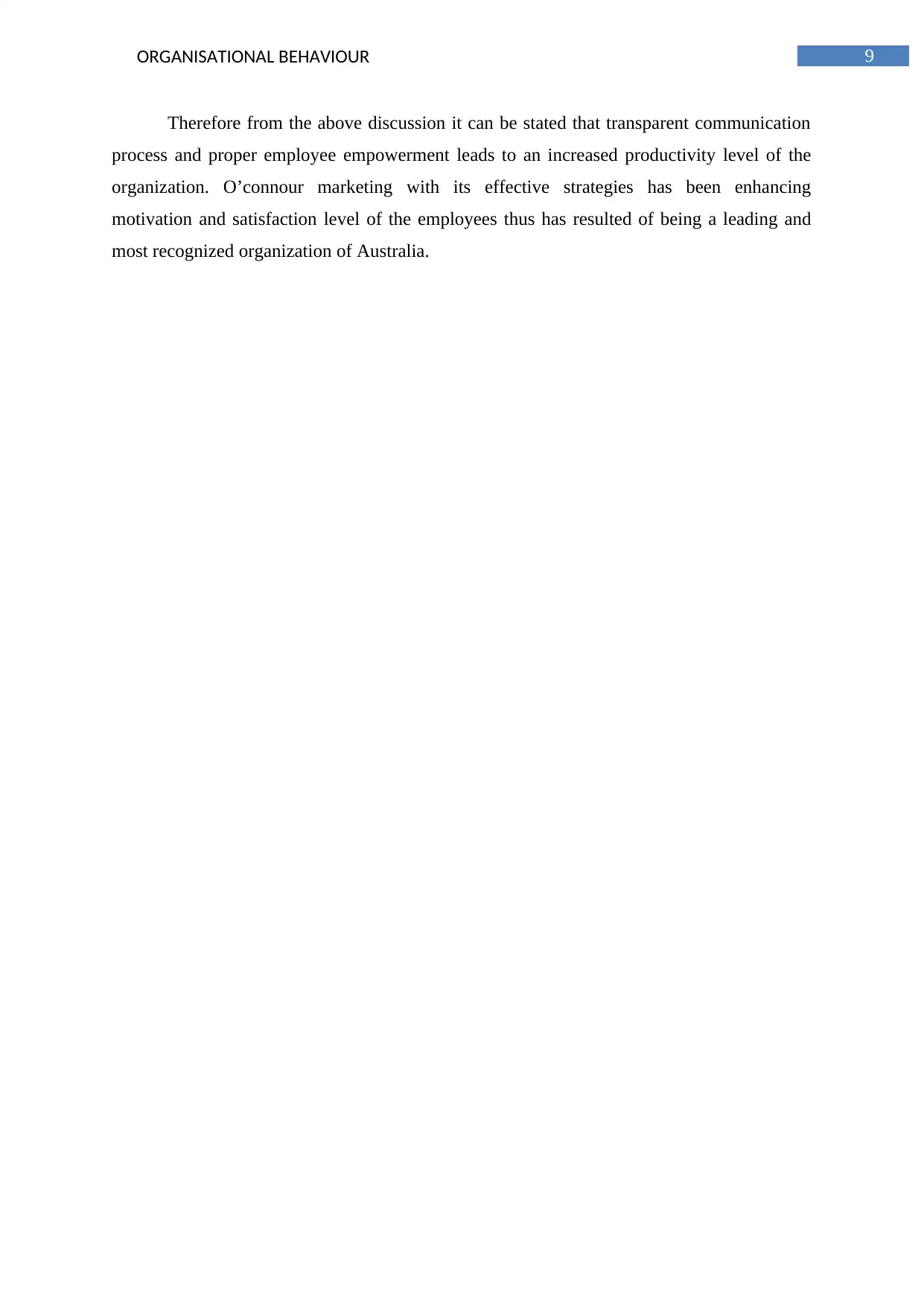
9ORGANISATIONAL BEHAVIOUR
Therefore from the above discussion it can be stated that transparent communication
process and proper employee empowerment leads to an increased productivity level of the
organization. O’connour marketing with its effective strategies has been enhancing
motivation and satisfaction level of the employees thus has resulted of being a leading and
most recognized organization of Australia.
Therefore from the above discussion it can be stated that transparent communication
process and proper employee empowerment leads to an increased productivity level of the
organization. O’connour marketing with its effective strategies has been enhancing
motivation and satisfaction level of the employees thus has resulted of being a leading and
most recognized organization of Australia.
Paraphrase This Document
Need a fresh take? Get an instant paraphrase of this document with our AI Paraphraser
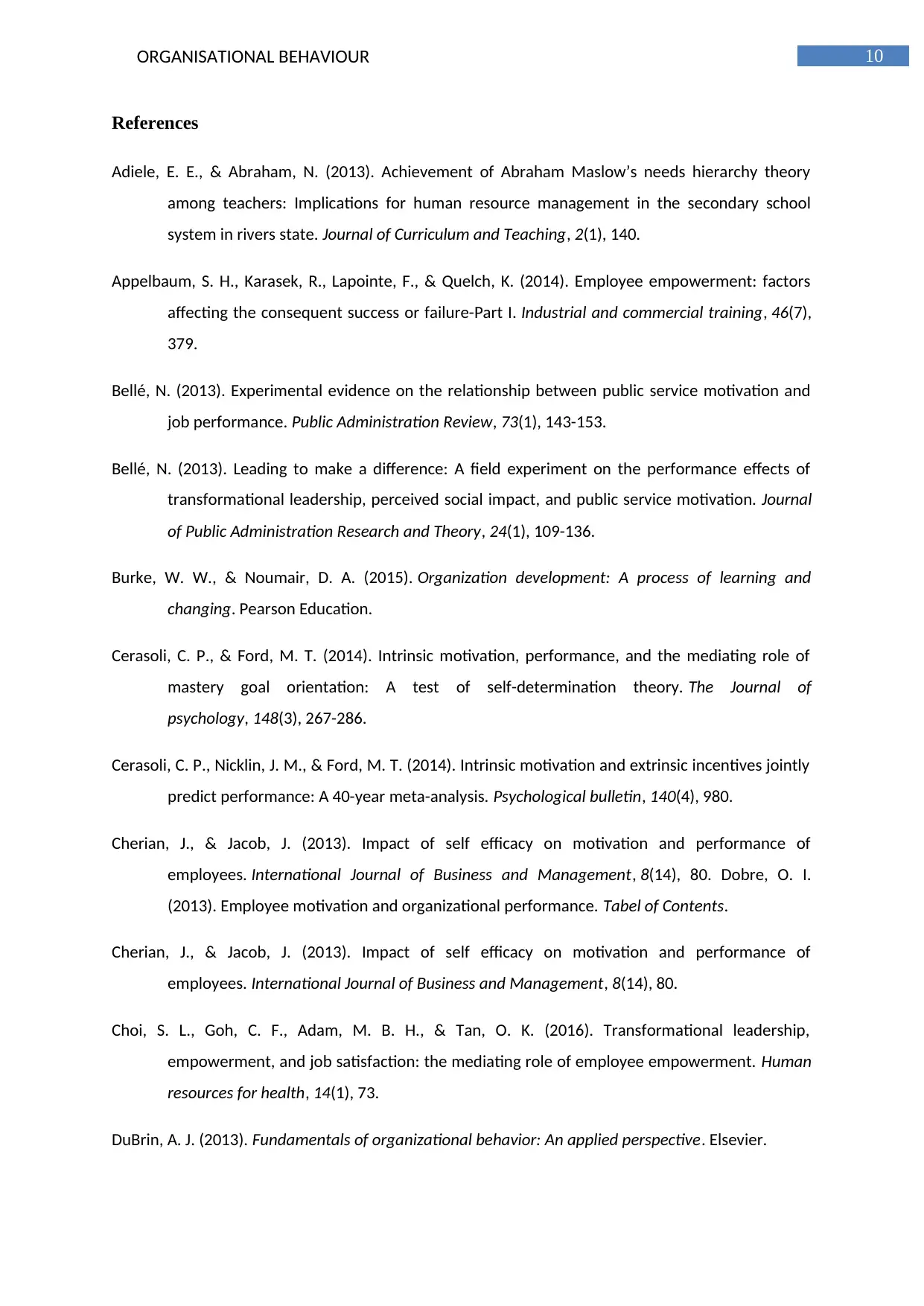
10ORGANISATIONAL BEHAVIOUR
References
Adiele, E. E., & Abraham, N. (2013). Achievement of Abraham Maslow’s needs hierarchy theory
among teachers: Implications for human resource management in the secondary school
system in rivers state. Journal of Curriculum and Teaching, 2(1), 140.
Appelbaum, S. H., Karasek, R., Lapointe, F., & Quelch, K. (2014). Employee empowerment: factors
affecting the consequent success or failure-Part I. Industrial and commercial training, 46(7),
379.
Bellé, N. (2013). Experimental evidence on the relationship between public service motivation and
job performance. Public Administration Review, 73(1), 143-153.
Bellé, N. (2013). Leading to make a difference: A field experiment on the performance effects of
transformational leadership, perceived social impact, and public service motivation. Journal
of Public Administration Research and Theory, 24(1), 109-136.
Burke, W. W., & Noumair, D. A. (2015). Organization development: A process of learning and
changing. Pearson Education.
Cerasoli, C. P., & Ford, M. T. (2014). Intrinsic motivation, performance, and the mediating role of
mastery goal orientation: A test of self-determination theory. The Journal of
psychology, 148(3), 267-286.
Cerasoli, C. P., Nicklin, J. M., & Ford, M. T. (2014). Intrinsic motivation and extrinsic incentives jointly
predict performance: A 40-year meta-analysis. Psychological bulletin, 140(4), 980.
Cherian, J., & Jacob, J. (2013). Impact of self efficacy on motivation and performance of
employees. International Journal of Business and Management, 8(14), 80. Dobre, O. I.
(2013). Employee motivation and organizational performance. Tabel of Contents.
Cherian, J., & Jacob, J. (2013). Impact of self efficacy on motivation and performance of
employees. International Journal of Business and Management, 8(14), 80.
Choi, S. L., Goh, C. F., Adam, M. B. H., & Tan, O. K. (2016). Transformational leadership,
empowerment, and job satisfaction: the mediating role of employee empowerment. Human
resources for health, 14(1), 73.
DuBrin, A. J. (2013). Fundamentals of organizational behavior: An applied perspective. Elsevier.
References
Adiele, E. E., & Abraham, N. (2013). Achievement of Abraham Maslow’s needs hierarchy theory
among teachers: Implications for human resource management in the secondary school
system in rivers state. Journal of Curriculum and Teaching, 2(1), 140.
Appelbaum, S. H., Karasek, R., Lapointe, F., & Quelch, K. (2014). Employee empowerment: factors
affecting the consequent success or failure-Part I. Industrial and commercial training, 46(7),
379.
Bellé, N. (2013). Experimental evidence on the relationship between public service motivation and
job performance. Public Administration Review, 73(1), 143-153.
Bellé, N. (2013). Leading to make a difference: A field experiment on the performance effects of
transformational leadership, perceived social impact, and public service motivation. Journal
of Public Administration Research and Theory, 24(1), 109-136.
Burke, W. W., & Noumair, D. A. (2015). Organization development: A process of learning and
changing. Pearson Education.
Cerasoli, C. P., & Ford, M. T. (2014). Intrinsic motivation, performance, and the mediating role of
mastery goal orientation: A test of self-determination theory. The Journal of
psychology, 148(3), 267-286.
Cerasoli, C. P., Nicklin, J. M., & Ford, M. T. (2014). Intrinsic motivation and extrinsic incentives jointly
predict performance: A 40-year meta-analysis. Psychological bulletin, 140(4), 980.
Cherian, J., & Jacob, J. (2013). Impact of self efficacy on motivation and performance of
employees. International Journal of Business and Management, 8(14), 80. Dobre, O. I.
(2013). Employee motivation and organizational performance. Tabel of Contents.
Cherian, J., & Jacob, J. (2013). Impact of self efficacy on motivation and performance of
employees. International Journal of Business and Management, 8(14), 80.
Choi, S. L., Goh, C. F., Adam, M. B. H., & Tan, O. K. (2016). Transformational leadership,
empowerment, and job satisfaction: the mediating role of employee empowerment. Human
resources for health, 14(1), 73.
DuBrin, A. J. (2013). Fundamentals of organizational behavior: An applied perspective. Elsevier.
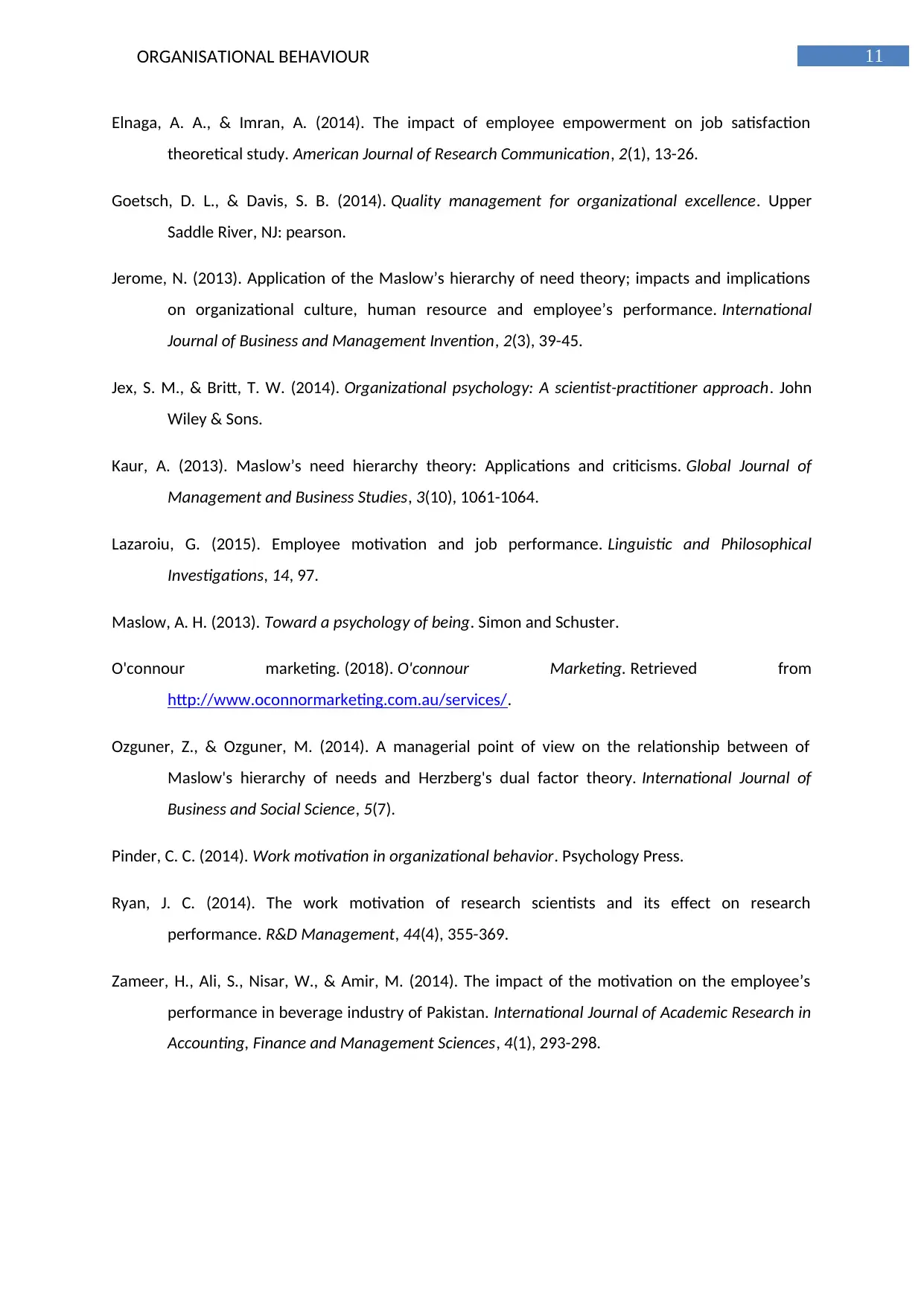
11ORGANISATIONAL BEHAVIOUR
Elnaga, A. A., & Imran, A. (2014). The impact of employee empowerment on job satisfaction
theoretical study. American Journal of Research Communication, 2(1), 13-26.
Goetsch, D. L., & Davis, S. B. (2014). Quality management for organizational excellence. Upper
Saddle River, NJ: pearson.
Jerome, N. (2013). Application of the Maslow’s hierarchy of need theory; impacts and implications
on organizational culture, human resource and employee’s performance. International
Journal of Business and Management Invention, 2(3), 39-45.
Jex, S. M., & Britt, T. W. (2014). Organizational psychology: A scientist-practitioner approach. John
Wiley & Sons.
Kaur, A. (2013). Maslow’s need hierarchy theory: Applications and criticisms. Global Journal of
Management and Business Studies, 3(10), 1061-1064.
Lazaroiu, G. (2015). Employee motivation and job performance. Linguistic and Philosophical
Investigations, 14, 97.
Maslow, A. H. (2013). Toward a psychology of being. Simon and Schuster.
O'connour marketing. (2018). O'connour Marketing. Retrieved from
http://www.oconnormarketing.com.au/services/.
Ozguner, Z., & Ozguner, M. (2014). A managerial point of view on the relationship between of
Maslow's hierarchy of needs and Herzberg's dual factor theory. International Journal of
Business and Social Science, 5(7).
Pinder, C. C. (2014). Work motivation in organizational behavior. Psychology Press.
Ryan, J. C. (2014). The work motivation of research scientists and its effect on research
performance. R&D Management, 44(4), 355-369.
Zameer, H., Ali, S., Nisar, W., & Amir, M. (2014). The impact of the motivation on the employee’s
performance in beverage industry of Pakistan. International Journal of Academic Research in
Accounting, Finance and Management Sciences, 4(1), 293-298.
Elnaga, A. A., & Imran, A. (2014). The impact of employee empowerment on job satisfaction
theoretical study. American Journal of Research Communication, 2(1), 13-26.
Goetsch, D. L., & Davis, S. B. (2014). Quality management for organizational excellence. Upper
Saddle River, NJ: pearson.
Jerome, N. (2013). Application of the Maslow’s hierarchy of need theory; impacts and implications
on organizational culture, human resource and employee’s performance. International
Journal of Business and Management Invention, 2(3), 39-45.
Jex, S. M., & Britt, T. W. (2014). Organizational psychology: A scientist-practitioner approach. John
Wiley & Sons.
Kaur, A. (2013). Maslow’s need hierarchy theory: Applications and criticisms. Global Journal of
Management and Business Studies, 3(10), 1061-1064.
Lazaroiu, G. (2015). Employee motivation and job performance. Linguistic and Philosophical
Investigations, 14, 97.
Maslow, A. H. (2013). Toward a psychology of being. Simon and Schuster.
O'connour marketing. (2018). O'connour Marketing. Retrieved from
http://www.oconnormarketing.com.au/services/.
Ozguner, Z., & Ozguner, M. (2014). A managerial point of view on the relationship between of
Maslow's hierarchy of needs and Herzberg's dual factor theory. International Journal of
Business and Social Science, 5(7).
Pinder, C. C. (2014). Work motivation in organizational behavior. Psychology Press.
Ryan, J. C. (2014). The work motivation of research scientists and its effect on research
performance. R&D Management, 44(4), 355-369.
Zameer, H., Ali, S., Nisar, W., & Amir, M. (2014). The impact of the motivation on the employee’s
performance in beverage industry of Pakistan. International Journal of Academic Research in
Accounting, Finance and Management Sciences, 4(1), 293-298.
⊘ This is a preview!⊘
Do you want full access?
Subscribe today to unlock all pages.

Trusted by 1+ million students worldwide
1 out of 12
Related Documents
Your All-in-One AI-Powered Toolkit for Academic Success.
+13062052269
info@desklib.com
Available 24*7 on WhatsApp / Email
![[object Object]](/_next/static/media/star-bottom.7253800d.svg)
Unlock your academic potential
Copyright © 2020–2025 A2Z Services. All Rights Reserved. Developed and managed by ZUCOL.





